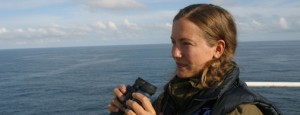WILDLIFE WATCHING – WHERE YOU WOULDN’T EXPECT IT!
By Chantal Cooke
I am looking at a meadow pipit – it’s in the middle of the North Sea sitting on the roof of a large container.
This tiny bird and its rather unexpected location sum up the miracle of migration.
In the autumn meadow pipits migrate southwards from northern Europe and they stop en-route at the Wadden Sea in Denmark to fill up on protein before attempting the long haul across the grey North Sea to Iberia and Africa.
Unfortunately this particular individual has picked the wrong ferry – as the Dana Sirena is heading away from the UK towards the port of Esjberg in Denmark – hopefully the rest will give this pipit the energy it needs to make the trip back the way we’ve come.
For many people an 18 hour ferry trip is simply a means of getting from A to B. We fill the time between ports with drinking, eating, watching DVDs, playing cards and sleeping.
But if you join DFDS’s Miracle of Migration mini cruise, the ferry trip becomes an integral part of the adventure.
As soon as the ship left Harwich our group met on the rear deck, binoculars hanging round our necks, eager to spot a Skua or maybe a fulmar (a member of the albatross family) or a graceful gannet.
Dylan Walker, from Planet Whale, is our guide and within moments he’s pointing out the wildlife that surrounds us. Our lenses eagerly scan the horizon and every now and again a shout goes up and everyone rushes to one side as an interesting specimen is spotted.
But some of the most fascinating birds are not fond out at sea – but sitting on the boat itself. A stunning orange and brown bramling hops about on the railings, and then a dunlin joins our meadow pipit on the lorries.
Looking down we see a solitary grey seal bobbing along in the wake of the ship.
Who would have thought that there’d be so much to see out here in the middle of nowhere?
On arrival in Esjberg it’s a quick 10 minute ferry ride to the island of Fano. Tens of thousands of birds make a pit stop on this island as they take part in the Spring and Autumn migrations.
Over the next day and half we’re treated to some amazing sites; a hooded crow mobbing a sparrow hawk; 3,000 black and white oyster catchers huddled along the water’s edge waiting for the tide to turn; a hen harrier swooping back and forth across the salt marshes in search of food; a tiny pied flycatcher sitting in the willows on the look-out for a passing meal; and over 20,000 dunlin taking to the air and forming a huge cloud above the water – they move like one large living organism, writhing back and forth, one moment black the next white, as they turn their pale bellies towards us. We gasp in awe.
Whether you’re an experienced birder with an encyclopaedic knowledge or a complete beginner struggling to recognise much more than a robin and a blackbird – you’ll come back with stories to tell and deeper love of nature.
From my experience a trip like this is a fantastic way to learn about birds. Those with the expertise (and the fancy ‘scopes) are very willing to share their knowledge and give you the opportunity to peer through their lenses to get a better look at a bird. Although we may stifle a grin at those people that carry around tripods and telescopes for bird watching, believe me they are not as daft as they may look. The view you get is so much better, the sense of being close to the bird so much stronger, and the ability to learn the tricks of identification so much easier.
I came back from my three days with a clearer understanding of migration and deeper appreciation for the nature around me.
For more information about DFDS Seaways Miracle of Migration Mini Cruise visit: DFDS
The next sailings depart; Sunday 15th May – Wednesday 18th May 2011 / Sunday 02nd Oct – Wednesday 05th October 2011 / Sunday 09th Oct – Wednesday 12th October 2011.
About the Author: Chantal Cooke is a professional journalist, co-founder of PASSION for the PLANET and a London Leader in Sustainability

